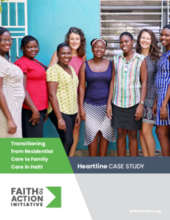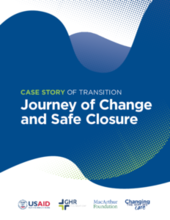The aim of this stage is to outwork care/case plans in preparation for the child leaving the residential care facility. Care/case plans may seek to overcome causes of separation and/or impacts of separation in preparation for reunification or prepare a child for placement in family-based alternative care. This stage also involves preparing young people who will transition out of care and into independent living.
In some cases, and only when it’s in the best interests of the child/ren, this stage may also involve placing children in other forms of alternative care whilst permanent reintegration planning/preparation continues. This could include foster care, kinship care or small group homes in some exceptional cases.
This stage is concerned with implementation of individual care/case plans in preparation for and up until the point of children’s placement back into their families or other permanent placements or the transition of youth into independent living.
Activities that might occur during this stage are specific to the care/case plans however might include:
- Improving the care setting/environment pre-reunification/placement
- Life skills training
- Vocational training
- Language and local culture acquisition (where children no longer speak their local language or dialect and have disconnected from their cultural practices)
- Job readiness training (youth)
- Protective behaviors training
- Counselling and/or other therapies
- Ongoing family re-connection and family visits
- Addressing addiction
- Family strengthening and capacity building
- Conflict resolution and positive parenting training
- Developing child and family safety plans
- Developing life books/life stories
- Creating opportunities for expression (dance, art, journaling etc.)
- Connecting children and youth with existing care leaver support services/peer networks
- Ensuring children with disabilities have assistive devices as needed and equipping homes with adaptations
- Connecting youth with community or peer mentors
- Connecting or referring children/families to government and community-based services
- Arranging for respite care services (where this is a feature of support plans)
- Preparing for school transfers
- Preparing for transfer of medical care to local clinics/hospitals
- Setting up or locating community-based services/rehabilitation for children with disabilities
- Preparing placement documentation with local authorities
- Conducting community engagement/sensitization activities and addressing any discrimination
- Preparing families and children for realistic expectations after placement/reunification
- Engaging community leaders in support and/or monitoring activities
- Preparing reintegration kits or packages (essential supplies)
- Helping families prepare the home
- Connecting to schools and preparing teachers for school reintegration
- Finding suitable accommodation for young people transitioning into independent living, including supported independent living services where required
- Connecting young people with aftercare services
- Farewell parties
- Participatory planning for the day of reunification/placement/transitiong with children, young people and families
- Community welcome events
Key milestones associated with this stage are:
- Children/youth and families have been well prepared for reunification/placement or transition to independent living
- All legal steps and procedures for reintegration/placement have been completed
- Safety and monitoring plans have been put in place for all children/youth
- Referrals to new services, including school transfers and course enrollments, have been completed to support children and their families post reunification/placement/transition
- All children/youth have been reunified, placed in more suitable alternative care settings (priority given to family-based) or have transitioned into independent living
Resources
Displaying 1 - 2 of 2
The story of Heartline’s transition from residential care to family care is told in this recently released Faith to Action case study. The case study details their experience through three stages of transition—learning, preparation and planning, and full transition—with transparency. It addresses common challenges for transitioning organizations, as well as the strategies Heartline took to overcome them.
The Journey of Change and Safe Closure case story demonstrates the process of early engagement and awareness to supporting the long-term reintegration of children in families.


